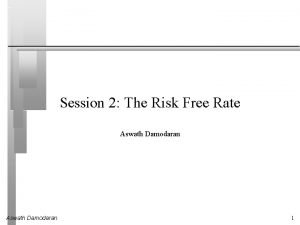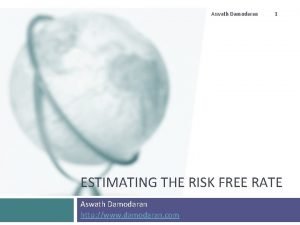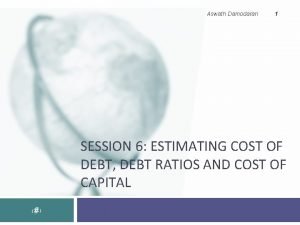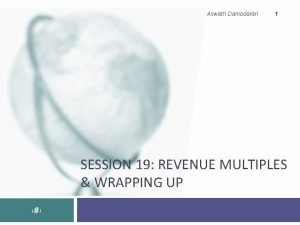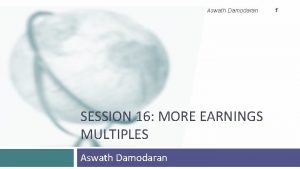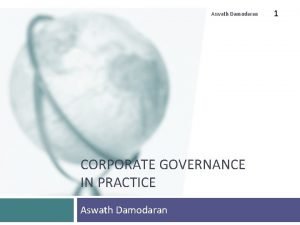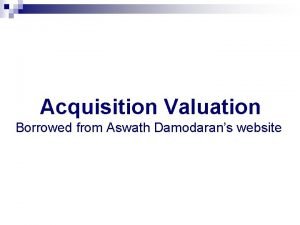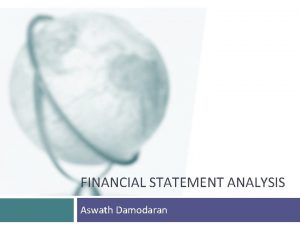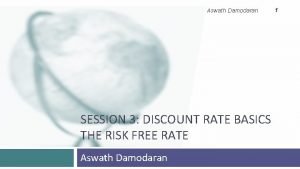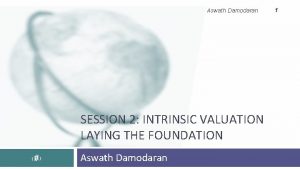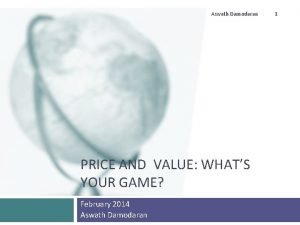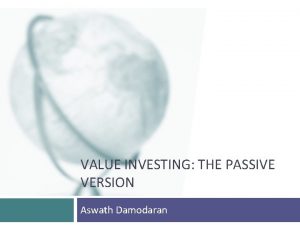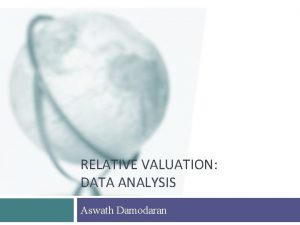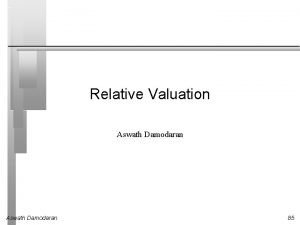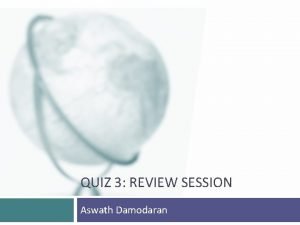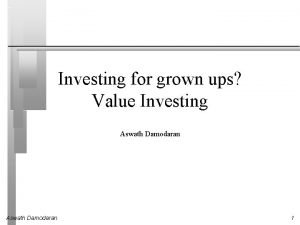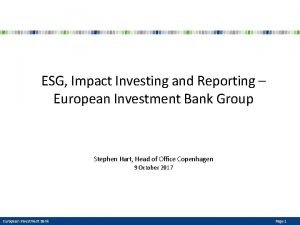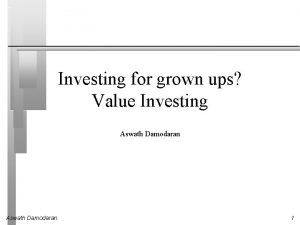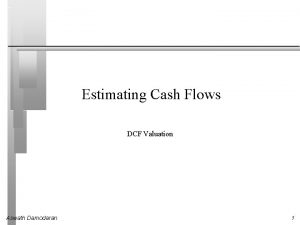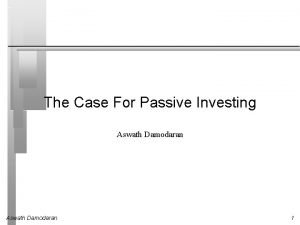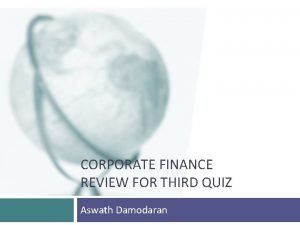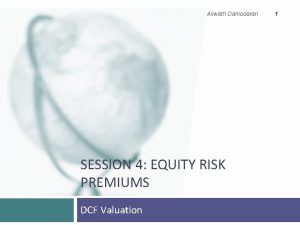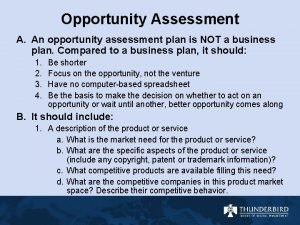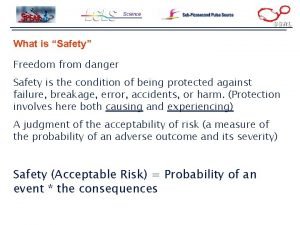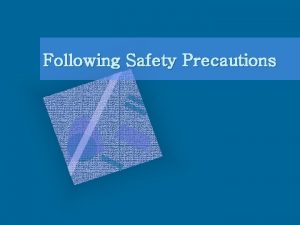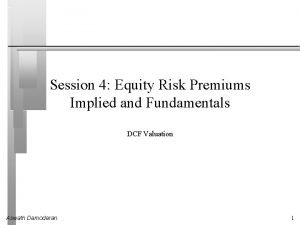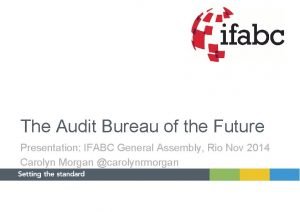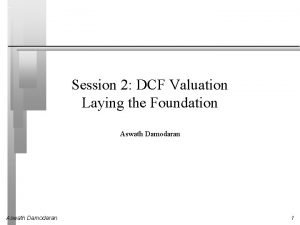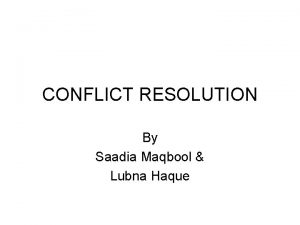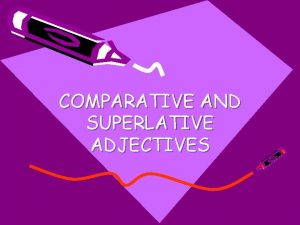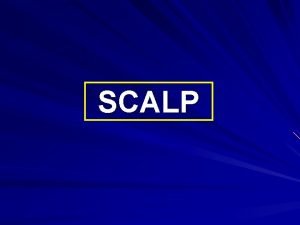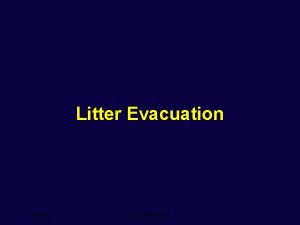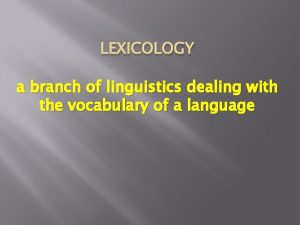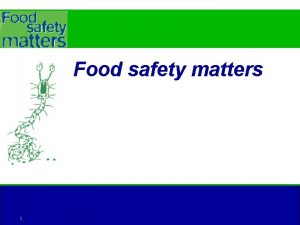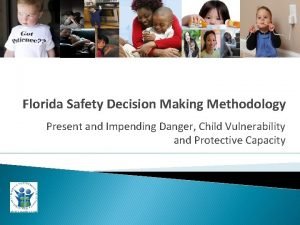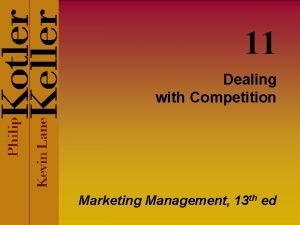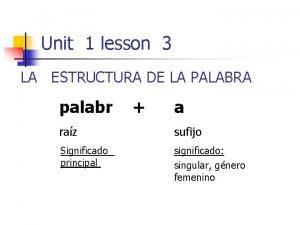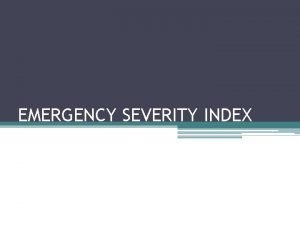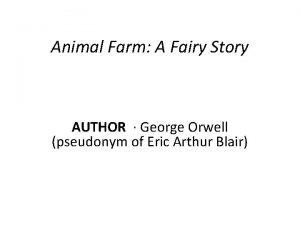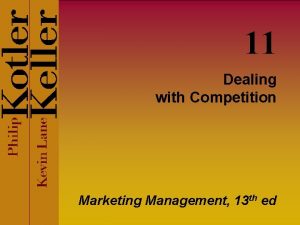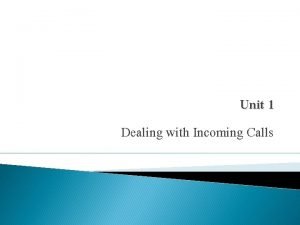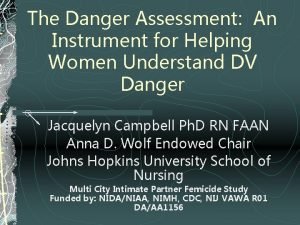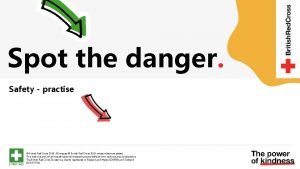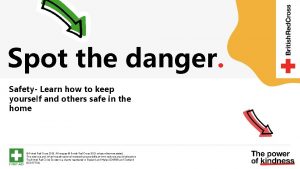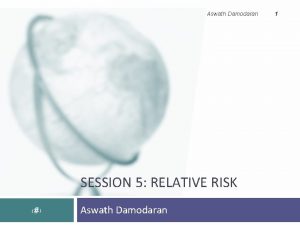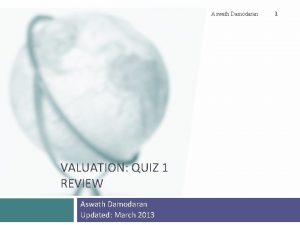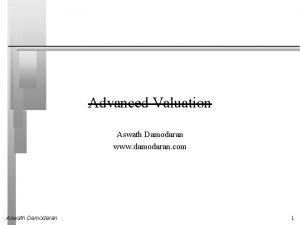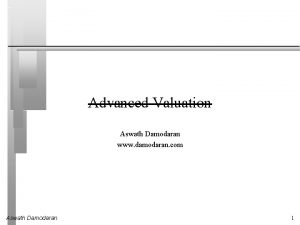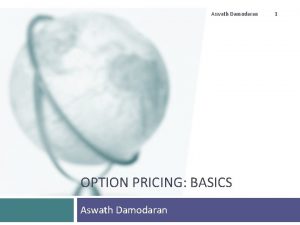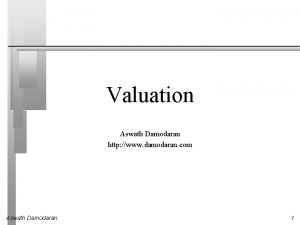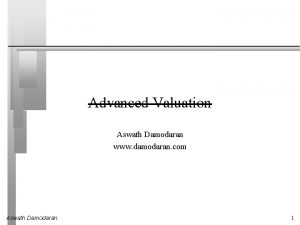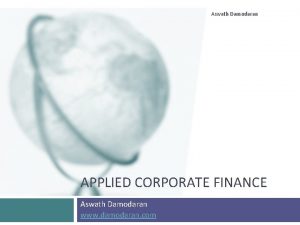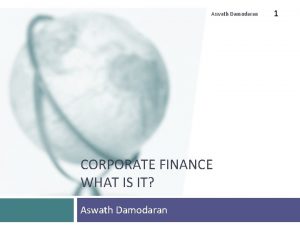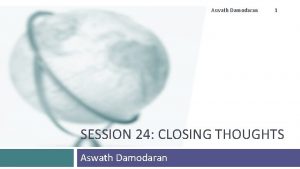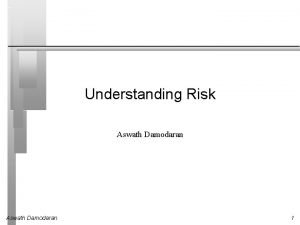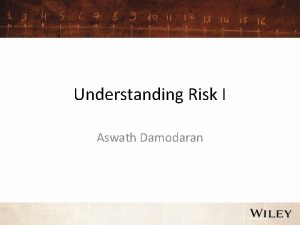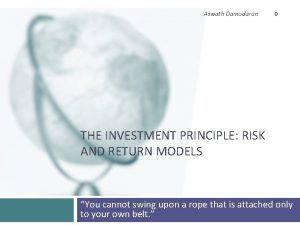Danger and Opportunity Dealing with Risk Aswath Damodaran




































![Austria [1] Belgium [1] Cyprus [1] Denmark Finland [1] Canada 4. 50% France [1] Austria [1] Belgium [1] Cyprus [1] Denmark Finland [1] Canada 4. 50% France [1]](https://slidetodoc.com/presentation_image_h/7607969ed9314e6ea94fb865101cf5b6/image-37.jpg)


















































- Slides: 87

Danger and Opportunity: Dealing with Risk Aswath Damodaran www. damodaran. com Aswath Damodaran 1

Here is a good definition of risk… Risk, in traditional terms, is viewed as a ‘negative’. Webster’s dictionary, for instance, defines risk as “exposing to danger or hazard”. The Chinese symbols for crisis, reproduced below, give a much better description of risk. The first symbol is the symbol for “danger”, while the second is the symbol for “opportunity”, making risk a mix of danger and opportunity. Aswath Damodaran 2

A good risk and return model should… 1. It should come up with a measure of risk that applies to all assets and not be asset-specific. 2. It should clearly delineate what types of risk are rewarded and what are not, and provide a rationale for the delineation. 3. It should come up with standardized risk measures, i. e. , an investor presented with a risk measure for an individual asset should be able to draw conclusions about whether the asset is above-average or below-average risk. 4. It should translate the measure of risk into a rate of return that the investor should demand as compensation for bearing the risk. 5. It should work well not only at explaining past returns, but also in predicting future expected returns. Aswath Damodaran 3

The Capital Asset Pricing Model Uses variance of actual returns around an expected return as a measure of risk. Specifies that a portion of variance can be diversified away, and that is only the non-diversifiable portion that is rewarded. Measures the non-diversifiable risk with beta, which is standardized around one. Translates beta into expected return Expected Return = Riskfree rate + Beta * Risk Premium Works as well as the next best alternative in most cases. Aswath Damodaran 4

The Mean-Variance Framework The variance on any investment measures the disparity between actual and expected returns. Low Variance Investment High Variance Investment Expected Return Aswath Damodaran 5

How risky is Disney? A look at the past… Aswath Damodaran 6

The Importance of Diversification: Risk Types Aswath Damodaran 7

The Effects of Diversification Firm-specific risk can be reduced, if not eliminated, by increasing the number of investments in your portfolio (i. e. , by being diversified). Market-wide risk cannot. This can be justified on either economic or statistical grounds. On economic grounds, diversifying and holding a larger portfolio eliminates firm-specific risk for two reasons(a) Each investment is a much smaller percentage of the portfolio, muting the effect (positive or negative) on the overall portfolio. (b) Firm-specific actions can be either positive or negative. In a large portfolio, it is argued, these effects will average out to zero. (For every firm, where something bad happens, there will be some other firm, where something good happens. ) Aswath Damodaran 8

A Statistical Proof that Diversification works… An example with two stocks. . Aswath Damodaran 9

The variance of a portfolio… Aswath Damodaran 10

A caveat on diversification: The lessons of 2008 Diversification reduces exposure to risks that are uncorrelated. It cannot eliminate your exposure to correlated risks. Two phenomena are undercutting the effectiveness of diversification: • • Globalization: As companies and investors globalize, the correlation across global economies and markets is increasing. The benefits to diversification are therefore dropping. Securitization: As more and more asset classes become securitized (accounts receivable, mortgages, commodities…), the correlation across asset classes is increasing. When there is a crisis of confidence and investors become more risk averse, the correlation across all risky assets increases, thus undercutting the benefits of diversification when you need it the most. Aswath Damodaran 11

The Role of the Marginal Investor The marginal investor in a firm is the investor who is most likely to be the buyer or seller on the next trade and to influence the stock price. Generally speaking, the marginal investor in a stock has to own a lot of stock and also trade a lot. Since trading is required, the largest investor may not be the marginal investor, especially if he or she is a founder/manager of the firm (Michael Dell at Dell Computers or Bill Gates at Microsoft) In all risk and return models in finance, we assume that the marginal investor is well diversified. Aswath Damodaran 12

Identifying the Marginal Investor in your firm… Aswath Damodaran 13

Analyzing the investor bases… Aswath Damodaran 14

Looking at Disney’s top stockholders in 2009 (again) Aswath Damodaran 15

The Market Portfolio Assuming diversification costs nothing (in terms of transactions costs), and that all assets can be traded, the limit of diversification is to hold a portfolio of every single asset in the economy (in proportion to market value). This portfolio is called the market portfolio. Individual investors will adjust for risk, by adjusting their allocations to this market portfolio and a riskless asset (such as a T-Bill) Preferred risk level No risk Some risk A little more risk Even more risk A risk hog. . Allocation decision 100% in T-Bills 50% in T-Bills; 50% in Market Portfolio; 25% in T-Bills; 75% in Market Portfolio 100% in Market Portfolio Borrow money; Invest in market portfolio Every investor holds some combination of the risk free asset and the market portfolio. Aswath Damodaran 16

The Risk of an Individual Asset The risk of any asset is the risk that it adds to the market portfolio Statistically, this risk can be measured by how much an asset moves with the market (called the covariance) Beta is a standardized measure of this covariance, obtained by dividing the covariance of any asset with the market by the variance of the market. It is a measure of the non-diversifiable risk for any asset can be measured by the covariance of its returns with returns on a market index, which is defined to be the asset's beta. The required return on an investment will be a linear function of its beta: Expected Return = Riskfree Rate+ Beta * (Expected Return on the Market Portfolio Riskfree Rate) Aswath Damodaran 17

Limitations of the CAPM 1. The model makes unrealistic assumptions 2. The parameters of the model cannot be estimated precisely - Definition of a market index - Firm may have changed during the 'estimation' period' 3. The model does not work well - If the model is right, there should be a linear relationship between returns and betas the only variable that should explain returns is betas - The reality is that the relationship between betas and returns is weak Other variables (size, price/book value) seem to explain differences in returns better. Aswath Damodaran 18

Alternatives to the CAPM Aswath Damodaran 19

Why the CAPM persists… The CAPM, notwithstanding its many critics and limitations, has survived as the default model for risk in equity valuation and corporate finance. The alternative models that have been presented as better models (APM, Multifactor model. . ) have made inroads in performance evaluation but not in prospective analysis because: • • • Aswath Damodaran The alternative models (which are richer) do a much better job than the CAPM in explaining past return, but their effectiveness drops off when it comes to estimating expected future returns (because the models tend to shift and change). The alternative models are more complicated and require more information than the CAPM. For most companies, the expected returns you get with the alternative models is not different enough to be worth the extra trouble of estimating four additional betas. 20

Ways of dealing with risk in analysis Risk Adjusted Value • • • Probabilistic Approaches • • • Estimate expected cash flows and adjust the discount rate for risk Use certainty equivalent cash flows and use the riskfree rate as the discount rate Hybrid approaches Sensitivity Analysis Decision Trees Simulations Value at Risk (VAR) and variants Real Options Aswath Damodaran 21

I. Risk Adjusted Value The value of a risky asset can be estimated by discounting the expected cash flows on the asset over its life at a risk-adjusted discount rate: where the asset has a n-year life, E(CFt) is the expected cash flow in period t and r is a discount rate that reflects the risk of the cash flows. Alternatively, we can replace the expected cash flows with the guaranteed cash flows we would have accepted as an alternative (certainty equivalents) and discount these at the riskfree rate: where CE(CFt) is the certainty equivalent of E(CFt) and rf is the riskfree rate. Aswath Damodaran 22

a. Risk Adjusted Discount Rates Step 1: Estimate the expected cash flows from a project/asset/business. If there is risk in the asset, this will require use to consider/estimate cash flows under different scenarios, attach probabilities to these scenarios and estimate an expected value across scenarios. In most cases, though, it takes the form of a base case set of estimates that capture the range of possible outcomes. Step 2: Estimate a risk-adjusted discount rate. While there a number of details that go into this estimate, you can think of a risk-adjusted discount rate as composed of two components Risk adjusted rate = Riskfree Rate + Risk Premium Step 3: Take the present value of the cash flows at the risk adjusted discount rate. Aswath Damodaran 23

A primer on risk adjusted discount rates Aswath Damodaran 24

i. A Riskfree Rate On a riskfree asset, the actual return is equal to the expected return. Therefore, there is no variance around the expected return. For an investment to be riskfree, then, it has to have • • 1. 2. No default risk No reinvestment risk Time horizon matters: Thus, the riskfree rates in valuation will depend upon when the cash flow is expected to occur and will vary across time. Not all government securities are riskfree: Some governments face default risk and the rates on bonds issued by them will not be riskfree. Aswath Damodaran 25

Comparing Riskfree Rates Aswath Damodaran 26

ii. Beta Estimation: A regression is not the answer… Aswath Damodaran 27

Beta Estimation: The Index Effect Aswath Damodaran 28

Betas don’t come from regressions: The determinants of betas Aswath Damodaran 29

One solution: Estimate sector (bottom up) betas The beta for a company measures its exposure to macro economic risk and should reflect: • • • The products and services it provides (and how discretionary they are) The fixed cost structure (higher fixed costs -> higher betas) The financial leverage (higher D/E ratio -> higher betas) For Grana Y Montero: Levered Beta = 0. 81 (1+ (1 -. 30) (433/2400)) = 0. 92 Proposition: When a firm is in multiple businesses with differing risk profiles, it should have different hurdle rates for each business. . Aswath Damodaran 30

Disney’s business breakdown Business Media Networks Comparable firms Radio and TV broadcasting companies -US Parks and Resorts Theme park & Resort companies - Global Number of Median firms levered beta Median D/E Unlevered beta Unlevered Median beta Cash/Firm corrected for Value cash 19 0. 83 38. 71% 0. 6735 4. 54% 0. 7056 26 0. 80 65. 10% 0. 5753 1. 64% 0. 5849 Studio Movie companies Entertainment US 19 1. 57 53. 89% 1. 1864 8. 93% 1. 3027 Consumer Products 12 0. 83 27. 21% 0. 7092 33. 66% 1. 0690 Toy companies- US Aswath Damodaran 31

A closer look at the process… Studio Entertainment Betas Aswath Damodaran 32

Disney’s bottom up beta Estimate the bottom up unlevered beta for Disney’s operating assets. Step 1: Start with Disney’s revenues by business. Step 2: Estimate the value as a multiple of revenues by looking at what the market value of publicly traded firms in each business is, relative to revenues. EV/Sales = Step 3: Multiply the revenues in step 1 by the industry average multiple in step 2. Disney has a cash balance of $3, 795 million. If we wanted a beta for all of Disney’s assets (and not just the operating assets), we would compute a weighted average: Aswath Damodaran 33

Disney’s Cost of Equity Step 1: Allocate debt across businesses Step 2: Compute levered betas and costs of equity for Disney’s operating businesses. Step 2 a: Compute the cost of equity for all of Disney’s assets: Equity Beta. Disney as company = 0. 6885 (1 + (1 – 0. 38)(0. 3691)) = 0. 8460 Riskfree Rate = 3. 5% Risk Premium = 6% Aswath Damodaran 34

iii. And equity risk premiums matter. . 1928 -2009 1960 -2009 2000 -2009 Aswath Damodaran Arithmetic Average Stocks – T. Bills T. Bonds 7. 53% 6. 03% (2. 28%) (2. 40%) 5. 48% 3. 78% (2. 42%) (2. 71%) -1. 59% -5. 47% (6. 73%) (9. 22%) Geometric Average Stocks – T. Bills T. Bonds 5. 56% 4. 29% 4. 09% 2. 74% -3. 68% -7. 22% Historical premium 35

Additional country risk? Even if we accept the proposition that an equity risk premium of about 4. 5% is reasonable for a mature market, you would expect a larger risk premium when investing in an emerging market. Consider Peru. There is clearly more risk investing in Peruvian equities than there is in investing in a mature market. To estimate the additional risk premium that should be charged, we follow a 3 -step process: • • Aswath Damodaran Step 1: Obtain a measure of country risk for Peru. For instance, the sovereign rating for Peru is Baa 3 and the default spread associated with that rating in early 2010 was 2%, Step 2: Estimate how much riskier equities are, relative to bonds. The standard deviation in weekly returns over the last 2 years for Peruvian equities was 26% and the standard deviation in the bond was 13%. Step 3: Additional risk premium for Peru = 2% ( 26/13 ) = 3% Step 4: Total equity risk premium for Peru = 4. 5%+3%=7. 5% 36
![Austria 1 Belgium 1 Cyprus 1 Denmark Finland 1 Canada 4 50 France 1 Austria [1] Belgium [1] Cyprus [1] Denmark Finland [1] Canada 4. 50% France [1]](https://slidetodoc.com/presentation_image_h/7607969ed9314e6ea94fb865101cf5b6/image-37.jpg)
Austria [1] Belgium [1] Cyprus [1] Denmark Finland [1] Canada 4. 50% France [1] Mexico 6. 90% Germany [1] United States of America 4. 50% Greece [1] Iceland Ireland [1] Italy [1] Malta [1] Netherlands [1] Norway Portugal [1] Spain [1] Sweden Switzerland Argentina 14. 25% United Kingdom Belize 14. 25% Bolivia 12. 75% Brazil 7. 50% Chile 5. 85% Colombia 7. 50% Costa Rica 8. 25% Ecuador 19. 50% El Salvador 19. 50% Guatemala 8. 25% Honduras 12. 75% Nicaragua 14. 25% Panama 8. 25% Paraguay 14. 25% Peru 7. 50% Uruguay 9. 75% Aswath Damodaran Venezuela 11. 25% Equity Risk Premiums January 2010 4. 50% 4. 95% 5. 63% 4. 50% 6. 08% 7. 50% 4. 95% 5. 40% 5. 85% 4. 50% 5. 40% 4. 50% Albania Armenia Azerbaijan Belarus Bosnia and Herzegovina Bulgaria Croatia Czech Republic Estonia Hungary Kazakhstan Latvia Lithuania Moldova Montenegro Poland Romania Russia Slovakia Slovenia [1] Turkmenistan Ukraine Bahrain Israel Jordan Kuwait Lebanon Oman Qatar Saudi Arabia United Arab Emirates 11. 25% 9. 00% 8. 25% 11. 25% 12. 75% 7. 50% 5. 85% 6. 90% 7. 20% 7. 50% 6. 90% 15. 75% 9. 75% 6. 08% 7. 50% 6. 90% 5. 85% 5. 40% 12. 75% 6. 08% Australia 5. 85% New Zealand 7. 50% 5. 40% 12. 75% 6. 08% 5. 40% 5. 85% 5. 40% 4. 50% 37

An example: Rio Disney Expected Cash flow in US $ (in April 2009) Aswath Damodaran 38

Rio Disney: Risk Adjusted Discount Rate Since the cash flows were estimated in US dollars, the riskfree rate is the US treasury bond rate of 3. 5% (at the time of the analysis. The beta for theme park business is 0. 7829. This was estimated by looking at publicly traded theme park companies. The risk premium is composed of two parts, a mature market premium of 6% and an additional risk premium of 3. 95% for Brazil. Country risk premium for Brazil = 3. 95% Cost of Equity in US$= 3. 5% + 0. 7829 (6%+3. 95%) = 11. 29% Using this estimate of the cost of equity, we use Disney’s theme park debt ratio of 35. 32% and its after-tax cost of debt of 3. 72%, we can estimate the cost of capital for the project: Cost of Capital in US$ = 11. 29% (0. 6468) + 3. 72% (0. 3532) = 8. 62% Aswath Damodaran 39

Rio Disney: Risk Adjusted Value Risk Adjusted Discount Rates Discounted at Rio Disney cost of capital of 8. 62% Aswath Damodaran 40

Does the currency matter? The analysis was done in dollars. Would the conclusions have been any different if we had done the analysis in Brazilian Reais? a) Yes b) No Aswath Damodaran 41

Disney Theme Park: $R NPV Discount at $R cost of capital Expected Exchange Ratet = Exchange Rate today * (1. 07/1. 02)t = (1. 0862) (1. 07/1. 02) – 1 = 13. 94% NPV = R$ 5, 870/2. 04= $ 2, 877 Million NPV is equal to NPV in dollar terms Aswath Damodaran 42

b. Certainty Equivalent You are investing in a risky environmen, where your cash flow next year look as follows: • $100 million, with 80% probability • -$100 million, with 20% probability What is the expected cash flow? How much would you accept as a guaranteed alternative to this investment? a) b) c) d) Aswath Damodaran $100 million $ 60 million More than $ 60 million Less than $ 60 million 43

Computing Certainty Equivalent cash flows right… Step 1: Convert your expected cash flow to a certainty equivalent. There are three ways you can do this: a. Compute certainty equivalents, using utility functions (forget this) b. Convert your expected cash flow to a certainty equivalent c. Subjectively estimate a haircut to the expected cash flows Step 2: Discount the certainty equivalent cash flows at the riskfree rate. Aswath Damodaran 44

Rio Disney: Risk Adjusted Value Certainty Equivalent Cash flows CFt* 1. 035 t/1. 0862 t Aswath Damodaran Discount at 3. 5% 45

II. Probabilistic Approaches The essence of risk that you are unclear about what the outcomes will be from an investment. In the risk adjusted cash flow approach, we make the adjustment by either raising discount rates or lowering cash flows. In probabilistic approaches, we deal with uncertainty more explicitly by • • • Aswath Damodaran Asking what if questions about key inputs and looking at the impact on value (Sensitivity Analysis) Looking at the cash flows/value under different scenarios for the future (Scenario Analysis) Using probability distributions for key inputs, rather than expected values, and computing value as a distribution as well (Simulations) 46

a. Sensitivity Analysis and What-if Questions… The NPV, IRR and accounting returns for an investment will change as we change the values that we use for different variables. One way of analyzing uncertainty is to check to see how sensitive the decision measure (NPV, IRR. . ) is to changes in key assumptions. While this has become easier and easier to do over time, there are caveats that we would offer. Caveat 1: When analyzing the effects of changing a variable, we often hold all else constant. In the real world, variables move together. Caveat 2: The objective in sensitivity analysis is that we make better decisions, not churn out more tables and numbers. Corollary 1: Less is more. Not everything is worth varying… Corollary 2: A picture is worth a thousand numbers (and tables). Aswath Damodaran 47

What if the cost of capital for Rio Disney were different (from 8. 62%)? Aswath Damodaran 48

b. Scenario Analysis Scenario analysis is best employed when the outcomes of a project are a function of the macro economic environment and/or competitive responses. As an example, assume that Boeing is considering the introduction of a new large capacity airplane, capable of carrying 650 passengers, called the Super Jumbo, to replace the Boeing 747. The cash flows will depend upon two major “uncontrollable” factors: • • Aswath Damodaran The growth in the long-haul, international market, relative to the domestic market. Arguably, a strong Asian economy will play a significant role in fueling this growth, since a large proportion of it will have to come from an increase in flights from Europe and North America to Asia. The likelihood that Airbus, Boeing’s primary competitor, will come out with a larger version of its largest capacity airplane, the A-300, over the period of the analysis. 49

The scenarios… Number of planes sold under each scenario (and probability of each scenario) Aswath Damodaran 50

c. Decision Trees Aswath Damodaran 51

With cash flows… Aswath Damodaran 52

And on outcome… Aswath Damodaran 53

Another use for decision trees: Dealing with nationalization risk… Assume that you are valuing Gazprom, the Russian oil company and have estimated a value of US $180 billion for the operating assets. The firm has $30 billion in debt outstanding. What is the value of equity in the firm? Now assume that the firm has 15 billion shares outstanding. Estimate the value of equity per share. The Russian government owns 42% of the outstanding shares. Would that change your estimate of value of equity per share? Aswath Damodaran 54

d. Simuations The Disney Theme Park Actual Revenues as % of Forecasted Revenues (Base case = 100%) Eq Equity Risk Premium (Base Case = 6% (US)+ 3. 95% (Brazil) = 9. 95% Operating Expenses at Parks as % of Revenues (Base Case = 60%) Aswath Damodaran 55

The resulting outcome… Average = $2. 95 billion Median = $2. 73 billion NPV ranges from -$4 billion to +$14 billion. NPV is negative 12% of the time. Aswath Damodaran 56

Using simulations in valuation: The Exxon Mobil valuation You are valuing Exxon Mobil, using data from the most recent fiscal year (2008). The following provides the key numbers: Revenues EBIT (1 -t) Net Cap Ex Chg WC FCFF $477 billion $ 58 billion $ 3 billion $ 1 billion $ 54 billion The cost of capital for the firm is 8% and you use a very conservative stable growth rate of 2% to value the firm. The market cap for the firm is $330 billion and it has $ 10 billion in debt outstanding. a. How under or over valued is the equity in the firm? b. Would you buy the stock based on this valuation? Why or why not? Aswath Damodaran 57

Normalization… not easy to do… but you don’t have a choice… Aswath Damodaran 58

And one possible response… Step 1: Look at history Step 3: Run simulation Step 2: Look for relationship Regression of Exxon income against oil price Op Inc = -6, 934 + 911 (Price per barrel of oil) R squared = 94% Aswath Damodaran 59

Choosing a Probabilistic Approach Aswath Damodaran 60

III. Value at Risk (Va. R) Value at Risk measures the potential loss in value of a risky asset or portfolio over a defined period for a given confidence interval. Thus, if the Va. R on an asset is $ 100 million at a one-week, 95% confidence level, there is a only a 5% chance that the value of the asset will drop more than $ 100 million over any given week. There are three key elements of Va. R – a specified level of loss in value, a fixed time period over which risk is assessed and a confidence interval. The Va. R can be specified for an individual asset, a portfolio of assets or for an entire firm Va. R has been used most widely at financial service firms, where the risk profile is constantly shifting and a big loss over a short period can be catastrophic (partly because the firms have relatively small equity, relative to the bets that they make, and partly because of regulatory constraints) Aswath Damodaran 61

Key Ingredients in Va. R To estimate the probability of the loss, with a confidence interval, we need to a. Define the probability distributions of individual risks, b. Estimate the correlation across these risks and c. Evaluate the effect of such risks on value. The focus in Va. R is clearly on downside risk and potential losses. Its use in banks reflects their fear of a liquidity crisis, where a low-probability catastrophic occurrence creates a loss that wipes out the capital and creates a client exodus. . Aswath Damodaran 62

Va. R Approaches I. III. Aswath Damodaran Variance Covariance Matrix: If we can estimate how each asset moves over time (variance) and how it moves with every other asset (covariance), we can mathematically estimate the Va. R. Weakness: The variances and covariances are usually estimated using historical data and are notoriously unstable (especially covariances_ Historical data simulation: If we know how an asset or portfolio has behaved in the past, we can use the historical data to make judgments of Va. R. Weakness: The past may not be a good indicator of the future. Monte Carlo Simulation: If we can specify return distributions for each asset/portfolio, we can run simulations to determine Va. R. Weakness: Garbage in, garbage out. A simulation is only as good as the distributions that go into it. 63

Limitations of Va. R Focus is too narrow: The focus on Va. R is very narrow. For instance, consider a firm that wants to ensure that it does not lose more than $ 100 million in a month and uses Va. R to ensure that this happens. Even if the Va. R is estimated correctly, the ensuing decisions may not be optimal or even sensible. The Va. R can be wrong: No matter which approach you use to estimate Va. R, it remains an estimate and can be wrong. Put another way, there is a standard error in the Va. R estimate that is large. The Black Swan: Va. R approaches, no matter how you frame them, have their roots in the past. As long as markets are mean reverting and stay close to historical norms, Va. R will work. If there is a structural break, Va. R may provide little or no protection against calamity. Aswath Damodaran 64

IV. Real Options One of the limitations of traditional investment analysis is that it is static and does not do a good job of capturing the options embedded in investment. • • • The first of these options is the option to delay taking a project, when a firm has exclusive rights to it, until a later date. The second of these options is taking one project may allow us to take advantage of other opportunities (projects) in the future The last option that is embedded in projects is the option to abandon a project, if the cash flows do not measure up. Unlike other risk adjustment approaches in finance, which tend to just penalize investments for risk, real options explicitly brings in the upside of risk into the analysis. Aswath Damodaran 65

The Option to Delay When a firm has exclusive rights to a project or product for a specific period, it can delay taking this project or product until a later date. A traditional investment analysis just answers the question of whether the project is a “good” one if taken today. Thus, the fact that a project does not pass muster today (because its NPV is negative, or its IRR is less than its hurdle rate) does not mean that the rights to this project are not valuable. Aswath Damodaran 66

Valuing the Option to Delay a Project PV of Cash Flows from Project Initial Investment in Project Present Value of Expected Cash Flows on Product Project has negative NPV in this section Aswath Damodaran Project's NPV turns positive in this section 67

An example: A Pharmaceutical patent Assume that a pharmaceutical company has been approached by an entrepreneur who has patented a new drug to treat ulcers. The entrepreneur has obtained FDA approval and has the patent rights for the next 17 years. While the drug shows promise, it is still very expensive to manufacture and has a relatively small market. Assume that the initial investment to produce the drug is $ 500 million and the present value of the cash flows from introducing the drug now is only $ 350 million. The technology and the market is volatile, and the annualized standard deviation in the present value, estimated from a simulation is 25%. Aswath Damodaran 68

Valuing the Patent Inputs to the option pricing model • • • Value of the Underlying Asset (S) = PV of Cash Flows from Project if introduced now = $ 350 million Strike Price (K) = Initial Investment needed to introduce the product = $ 500 million Variance in Underlying Asset’s Value = (0. 25)2 = 0. 0625 Time to expiration = Life of the patent = 17 years Dividend Yield = 1/Life of the patent = 1/17 = 5. 88% (Every year you delay, you lose 1 year of protection) Assume that the 17 -year riskless rate is 4%. The value of the option can be estimated as follows: Call Value= 350 exp(-0. 0588)(17) (0. 5285) -500 (exp(-0. 04)(17) (0. 1219)= $ 37. 12 million Aswath Damodaran 69

Insights for Investment Analyses Having the exclusive rights to a product or project is valuable, even if the product or project is not viable today. The value of these rights increases with the volatility of the underlying business. The cost of acquiring these rights (by buying them or spending money on development - R&D, for instance) has to be weighed off against these benefits. Aswath Damodaran 70

The Option to Expand/Take Other Projects Taking a project today may allow a firm to consider and take other valuable projects in the future. Thus, even though a project may have a negative NPV, it may be a project worth taking if the option it provides the firm (to take other projects in the future) has a more-than-compensating value. These are the options that firms often call “strategic options” and use as a rationale for taking on “negative NPV” or even “negative return” projects. Aswath Damodaran 71

The Option to Expand PV of Cash Flows from Expansion Additional Investment to Expand Present Value of Expected Cash Flows on Expansion Firm will not expand in this section Aswath Damodaran Expansion becomes attractive in this section 72

An Example of an Expansion Option Disney is considering investing $ 100 million to create a Spanish version of the Disney channel to serve the growing Mexican market. A financial analysis of the cash flows from this investment suggests that the present value of the cash flows from this investment to Disney will be only $ 80 million. Thus, by itself, the new channel has a negative NPV of $ 20 million. If the market in Mexico turns out to be more lucrative than currently anticipated, Disney could expand its reach to all of Latin America with an additional investment of $ 150 million any time over the next 10 years. While the current expectation is that the cash flows from having a Disney channel in Latin America is only $ 100 million, there is considerable uncertainty about both the potential for such an channel and the shape of the market itself, leading to significant variance in this estimate. Aswath Damodaran 73

Valuing the Expansion Option Value of the Underlying Asset (S) = PV of Cash Flows from Expansion to Latin America, if done now =$ 100 Million Strike Price (K) = Cost of Expansion into Latin American = $ 150 Million We estimate the variance in the estimate of the project value by using the annualized standard deviation in firm value of publicly traded entertainment firms in the Latin American markets, which is approximately 30%. • Variance in Underlying Asset’s Value = 0. 302 = 0. 09 Time to expiration = Period of expansion option = 10 years Riskless Rate = 4% Call Value= $ 36. 3 Million Aswath Damodaran 74

Considering the Project with Expansion Option NPV of Disney Channel in Mexico = $ 80 Million - $ 100 Million = - $ 20 Million Value of Option to Expand = $ 36. 3 Million NPV of Project with option to expand = - $ 20 million + $ 36. 3 million = $ 16. 3 million Take the first investment, with the option to expand. Aswath Damodaran 75

The Option to Abandon A firm may sometimes have the option to abandon a project, if the cash flows do not measure up to expectations. If abandoning the project allows the firm to save itself from further losses, this option can make a project more valuable. PV of Cash Flows from Project Cost of Abandonment Present Value of Expected Cash Flows on Project Aswath Damodaran 76

Valuing the Option to Abandon Disney is considering taking a 25 -year project which • • requires an initial investment of $ 255 million in an real estate partnership to develop time share properties with a South Florida real estate developer, has a present value of expected cash flows is $ 254 million. While the net present value is negative, assume that Disney has the option to abandon this project anytime by selling its share back to the developer in the next 5 years for $ 150 million. A simulation of the cash flows on this time share investment yields a variance in the present value of the cash flows from being in the partnership is 0. 04. Aswath Damodaran 77

Project with Option to Abandon Value of the Underlying Asset (S) = PV of Cash Flows from Project = $ 254 million Strike Price (K) = Salvage Value from Abandonment = $ 150 million Variance in Underlying Asset’s Value = 0. 04 Time to expiration = Abandonment period =5 years Dividend Yield = 1/Life of the Project = 1/25 = 0. 04 (We are assuming that the project’s present value will drop by roughly 1/n each year into the project) Assume that the five-year riskless rate is 4%. Aswath Damodaran 78

Should Disney take this project? Call Value = 254 exp(0. 04)(5) (0. 9194) -150 (exp(-0. 04)(5) (0. 8300) = $ 89. 27 million Put Value= $ 89. 27 - 254 exp(0. 04)(5) +150 (exp(-0. 04)(5) = $ 4. 13 million The value of this abandonment option has to be added on to the net present value of the project of -$ 1 million, yielding a total net present value with the abandonment option of $ 3. 13 million. Aswath Damodaran 79

How do we manage risk? Aswath Damodaran 80

Determinants of Value Aswath Damodaran 81

When Risk Hedging/Management Matters. . For an action to affect value, it has to affect one or more of the following inputs into value: • • Cash flows from existing assets Growth rate during excess return phase Length of period of excess returns Discount rate Proposition 1: Risk hedging/management can increase value only if they affect cash flows, growth rates, discount rates and/or length of the growth period. Proposition 2: When risk hedging/management has no effect on cash flows, growth rates, discount rates and/or length of the growth period, it can have no effect on value. Aswath Damodaran 82

Risk Hedging/ Management and Value Aswath Damodaran 83

Does hedging affect value? Studies that examine whether hedging increase value range from finding marginal gains to mild losses. • • • Smithson presents evidence that he argues is consistent with the notion that risk management increases value, but the increase in value at firms that hedge is small and not statistically significant. Mian finds only weak or mixed evidence of the potential hedging benefits– lower taxes and distress costs or better investment decisions. In fact, the evidence in inconsistent with a distress cost model, since the companies with the greatest distress costs hedge the least. Tufano’s study of gold mining companies finds little support for the proposition that hedging is driven by the value enhancement In summary, the benefits of hedging are hazy at best and non-existent at worst, when we look at publicly traded firms. A reasonable case can be made that most hedging can be attributed to managerial interests being served rather than increasing stockholder value. Aswath Damodaran 84

A framework for risk hedging. . Aswath Damodaran 85

b. Risk Taking: Effect on Value Aswath Damodaran 86

How do you exploit risk? a. b. c. d. e. To exploit risk better than your competitors, you need to bring something to the table. In particular, there are five possible advantages that successful risk taking firms exploit: Information Advantage: In a crisis, getting better information (and getting it early) can allow be a huge benefit. Speed Advantage: Being able to act quickly (and appropriately) can allow a firm to exploit opportunities that open up in the midst of risk. Experience/Knowledge Advantage: Firms (and managers) who have been through similar crises in the past can use what they have learned. Resource Advantage: Having superior resources can allow a firm to withstand a crisis that devastates its competition. Flexibility: Building in the capacity to change course quickly can be an advantage when faced with risk. Aswath Damodaran 87
 Risk free rate damodaran
Risk free rate damodaran Risk free rate damodaran
Risk free rate damodaran Www.damodaran
Www.damodaran Damodaran com
Damodaran com Value investing damodaran
Value investing damodaran Aswath damodaran statistics
Aswath damodaran statistics Aswath damodaran interest coverage ratio
Aswath damodaran interest coverage ratio Aswath damodaran multiples
Aswath damodaran multiples Aswath damodaran net worth
Aswath damodaran net worth Damodaran discount rates
Damodaran discount rates Damodaran ebitda multiples
Damodaran ebitda multiples Aswath damodaran age
Aswath damodaran age Aswath damodaran website
Aswath damodaran website Contrarian value investing
Contrarian value investing Aswath damodaran accounting 101
Aswath damodaran accounting 101 Aswath damodaran
Aswath damodaran Aswath damodaran discount rate
Aswath damodaran discount rate Aswath damodaran intrinsic value
Aswath damodaran intrinsic value Aswath damodaran intrinsic value
Aswath damodaran intrinsic value Aswath damodaran value investing
Aswath damodaran value investing Aswath damodaran formação
Aswath damodaran formação Aswath damodaran data
Aswath damodaran data Aswath damodaran multiples
Aswath damodaran multiples Damodaran on valuation review
Damodaran on valuation review Aswath damodaran value investing
Aswath damodaran value investing Damodaran discount rates
Damodaran discount rates Aswath damodaran esg
Aswath damodaran esg Damodaran
Damodaran Dcf aswath
Dcf aswath Aswath damodaran
Aswath damodaran Quiz
Quiz Damodaran dcf
Damodaran dcf Aswath damodaran
Aswath damodaran Opportunity
Opportunity Freedom from danger
Freedom from danger Freedom from danger risk or injury
Freedom from danger risk or injury Market risk credit risk operational risk
Market risk credit risk operational risk Implied premium
Implied premium Ifabc
Ifabc Dcf aswath
Dcf aswath Chapter 5 lesson 1 dealing with anxiety and depression
Chapter 5 lesson 1 dealing with anxiety and depression Chapter 5 lesson 1 dealing with anxiety and depression
Chapter 5 lesson 1 dealing with anxiety and depression Warning and danger signs of conflict
Warning and danger signs of conflict Superlative adjective dangerous
Superlative adjective dangerous Residual risk and secondary risk pmp
Residual risk and secondary risk pmp Business vs financial risk
Business vs financial risk Relative risk calculation
Relative risk calculation Attributable risk formula
Attributable risk formula Lime soda process of water softening
Lime soda process of water softening Danger area of the scalp
Danger area of the scalp What is the food danger zone
What is the food danger zone Extreme danger gap
Extreme danger gap Valve galea
Valve galea Parapharyngeal space
Parapharyngeal space Litter evacuation
Litter evacuation Assimilation linguistics
Assimilation linguistics Cascade sous marine ile maurice
Cascade sous marine ile maurice General danger signs
General danger signs What is the food danger zone
What is the food danger zone Cycle of transmission food safe
Cycle of transmission food safe Impending danger threats
Impending danger threats Biotic
Biotic Section 2 dealing with other nations
Section 2 dealing with other nations Call center stress syndrome
Call center stress syndrome Asea redox bienfaits
Asea redox bienfaits Danger area of the scalp
Danger area of the scalp Danger space neck
Danger space neck Jet blast danger area
Jet blast danger area Market follower
Market follower Triste es un adjetivo
Triste es un adjetivo The genre of speculative fiction dealing with concepts
The genre of speculative fiction dealing with concepts Our planet is in danger
Our planet is in danger Site:slidetodoc.com
Site:slidetodoc.com Esi triage examples
Esi triage examples Crossing a linear danger area
Crossing a linear danger area Albeda danger
Albeda danger What was george orwell's real name
What was george orwell's real name What is the conflict in animal farm
What is the conflict in animal farm Dealing with competition marketing management
Dealing with competition marketing management The danger of silence summary
The danger of silence summary Unit 1 dealing with incoming calls
Unit 1 dealing with incoming calls Ms risk factors
Ms risk factors Dealing with anger in the bible
Dealing with anger in the bible What is symbolism?
What is symbolism? Dealing successfully with difficult changes in your life.
Dealing successfully with difficult changes in your life. Spot the danger
Spot the danger Spot the danger
Spot the danger Lexicology as a branch of linguistics
Lexicology as a branch of linguistics
